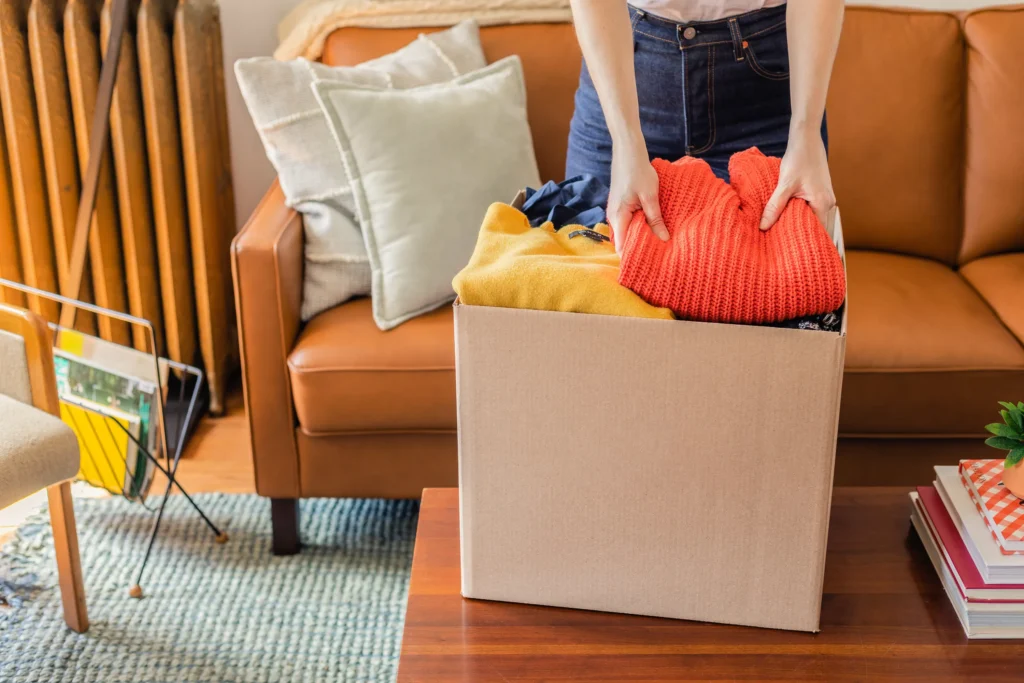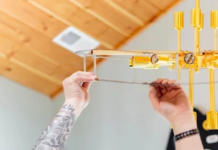Decluttering or removing things from your home that are no longer needed is important if you like to stay organized. Follow these tips to make decluttering easier.

“Make Space in Your Life for What Matters”
Decluttering refers to the process of simplifying your life. It is the way you can get rid of unnecessary things in your space, making the place minimal, and welcoming of new things and experiences. However, this process of taking things you no longer need and making space for newer, more exciting things can be exhausting. According to experts, the best way to prevent feeling overwhelmed during the decluttering process is to do it in stages and steps. Creating a decluttering checklist and focusing on one room, or a section of a particular room makes you stress less. This way you can complete one area thoroughly before moving to the next place and the entire process is easier. With tips like this, the entire process can be even more simplified and less stressful for you. So, let’s see what the tips are –
Why decluttering your space is essential?
Before moving forward to the tips, it is important to know the basics. Starting with the age-old question, of why decluttering your space is essential. Well, the process holds so many benefits for you. Such as –
- Messy and crowded spaces often create anxiety so decluttering can reduce it.
- You will have less stuff to clean.
- Organizing a space will no longer feel stressful for you because you will have fewer things on your hands.
- De-cluttered spaces make people focus more on tasks.
- Finding items in need will be easier and faster.
With all these benefits, decluttering is a necessity to keep your daily life stressless, especially if you like to stay clean and organized. A clean and organized place would also give you positive energy, reflecting on your mood and life.
Now that you know the advantages of decluttering and how it can impact your daily life, let’s move on to the tips that you have been waiting for.
Tips for organizing and simplifying your space – decluttering
- Create a decluttering strategy
Before diving into your decluttering journey, it is essential to have a clear plan in place. Start by outlining a realistic timeline that works with your schedule and energy levels. Now, break the process into small and manageable portions to avoid feeling overwhelmed. You can identify which area of your home needs the most attention and then prioritize accordingly. For example, maybe you can start with the room that gathers the most clutter or the space you use most often.
Now, it is time to map out your goals for each room. For example, aiming to transform your living room into a calming space or reclaiming your bedroom as a serene retreat. Be specific about what you want to achieve in each area, whether it is creating more storage, donating unused items, or simply restoring order. This would be your roadmap that will keep you focused and motivated throughout the entire decluttering journey.
- Give every item a dedicated space
The saying “a place for everything and everything in its place” is a great rule for staying organized. According to this saying, every item you own should have a specific spot where it belongs. Following this keeps your home tidy and makes it easier to find things – the goal of decluttering.
If you can’t find a place for something, ask yourself if you really need it. If not, it might be time to let it go. If you do need it, make space by getting rid of something less important. Keeping this balance will help your home stay neat, clutter-free, and also welcoming of new things.
- Get rid of the “Guilty” feeling
Feeling guilty about getting rid of sentimental items or gifts is completely normal. These objects often hold memories of emotional significance, making it tough to decide to get rid of them. While it is okay to acknowledge those feelings, it is also important to remember that holding onto clutter can bring its own kind of guilt, such as feeling overwhelmed by a crowded space or frustrated by the lack of order in your own space.
If you are hesitant to let go of something meaningful but no longer useful to you, consider donating or selling it. Donating gives the item a new purpose and allows someone else to enjoy it. Selling it can also feel good, as you are passing it on to someone who truly needs or wants the item. Additionally, you will have the money for something meaningful to you. It can be a special experience, a hobby, or an improvement to your home. These can help turn those feelings of guilt into delight.
- Start with small projects
If the idea of decluttering your entire home feels stressful, you are not alone. It is hard to know where to start, especially when a room looks like a big job. So, instead of trying to tackle everything at once, begin with smaller projects. Start by cleaning out a drawer, a shelf, or even just one counter. When you finish these smaller tasks, it will give you a sense of achievement and motivate you to keep going.
With the completion of more and more small tasks, you will feel more confident and ready to take on bigger decluttering tasks. The rule is simple, the more you do, the easier it becomes. So, celebrate each small win along the way and you will stay motivated throughout. In no time, you will also have cleared out several spaces, and what once felt like an impossible task will seem much more manageable.
- Coupling similar things
When you are decluttering your home, it helps to group similar items. This simple step will make organizing the space easier and help keep things in order. By sorting your items into categories, you will not only clear out clutter but also make your daily life smoother. Once you have grouped everything, store each category in a place where you will use it most often. For example, keep office supplies in a tote or drawer in your home office so they’re easy to grab when you need them. The formula for the children’s toys is to store them in labeled bins in the basement or playroom. This makes the cleanup or picking up an easier task.
Remember, the goal is to keep things close to where they are used most often, so you always know exactly where to find them. This method helps you stay organized and reduces the stress of searching for things.
- Keep flat surfaces clean
Flat surfaces like countertops, shelves, and tables are the easiest places for clutter to build up. While it’s fine to leave a few things out, aim to keep these areas mostly clear. This will make your home look cleaner and more organized.
For things that you need to keep on your counters, try to limit them to just the essentials. Store items you don’t need daily in drawers or use small boxes or bins on shelves to keep papers and other items tidy. In the kitchen, it’s okay to leave small appliances you use often on the counter, but anything that’s rarely used should be put away or donated to save space and reduce clutter. By clearing off these surfaces, you create a more open, inviting space and make it easier to maintain an organized home.
- The 80/20 rule
It is often said that 80% of the time, we only use 20% of the things we own. This rule, known as the Pareto principle, is true for many items in our lives, not just clothing and it imposes an important principle for your decluttering journey. Think about your wardrobe; what are you likely to wear only a small fraction of the clothes you own regularly? The same can be said for things like video games, books, DVDs, electronics, and even toys. Now wonder how many of those items are gathering dust, or simply taking up space?
The key to decluttering is identifying those things you don’t use 80% of the time and letting them go. For example, if you have clothes in your closet that haven’t been worn in months or books that just sit on the shelf without being opened, it might be the best time to consider donating, selling, or discarding them. This approach is not just about getting rid of stuff, but it is about freeing up space for the things that truly matter in your own space and things that you actually use and enjoy.
When you focus on the items that you use the least, it will be easier to simplify your life and create more space for the things that hold value. This is an improvised process of letting go that allows you to focus on quality over quantity. It also helps in making your space more meaningful and functional.
- Ditch the sunk cost
In economics, “sunk cost” refers to money you’ve already spent and cannot t recover. Once you’ve bought something, the money is gone. So, it is important to focus on how much value the item brings to your life now, rather than its original price.
For example, many people hesitate to sell expensive items like kitchen appliances—even if they never use them. Take a Kitchenaid mixer for instance. It may have cost a lot upfront, but if it is sitting unused on your counter, it is of no benefit to you. Instead of holding onto it because of its price, consider how much more space you could have in your kitchen if you let it go. The counter space could make cooking easier and your kitchen more enjoyable to use.
The key here is to focus on the present value of what you own. Hanging onto things because they were expensive in the first place does not help you now. Letting go of unused items, on the other hand, frees up space and improves your daily life. So, it is worth considering the true value they offer today, rather than what they originally cost.
- Check the functionality of items
If you come across something hidden away that you thought was valuable, but it does not work properly, it is time to decide what to do with it. If you are determined to fix it, take the time to repair it right away. However, if you are not sure how to fix it or don’t plan on using it anytime soon, it would be best to let it go. Otherwise, it will just sit there, taking up space and gathering dust.
Keeping broken or unused items around can create unnecessary clutter. It is better to either fix them promptly or get rid of them if they no longer add any value to your life. This way, you are making room for things that are useful and meaningful, rather than holding onto things that just take up space.
- Think of the last time you used
If you find something you haven’t used in the past six months, it’s a good sign you don’t need it anymore. If you pull it out and think, “Oh, I’ve been wondering where this was!” it’s still worth considering whether it’s truly needed, but you can likely let it go. Moreover, if you didn’t even remember you had the item in the first place, that is a clear sign to get rid of it. You haven’t missed it, so it probably means that the thing does not deserve a place in your home.
Holding onto things you don’t use or forget about just takes up space and adds to clutter. If you haven’t needed something in months and didn’t even notice it was gone, it clearly means that it is not adding any value to your life. Letting go of these items can help make room for things that you actually use and enjoy.
- Sleep on it
Once you have absolutely decided to declutter your home, give yourself some time to think it over. Sleep on it before making any final decisions. If there’s anything you’re unsure about and realize you really can’t live without, you’ll know by the next morning. At that point, you can take it out of the donation or discard pile and put it back where it belongs in your space. This extra time helps you avoid second-guessing your choices and ensures you only get rid of what you truly don’t need. It also gives you a clearer perspective on what really matters to you.
The easiest and fastest way to declutter your home is to make a categorized list and stick to it. Start by room from room and list which areas need to be decluttered. There you go, stick to the list and apply the tips!
































